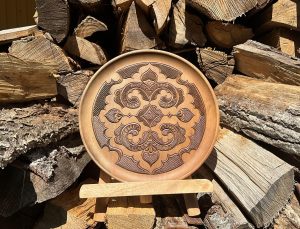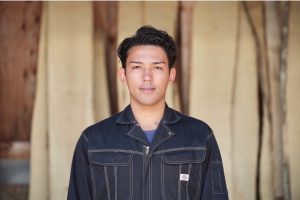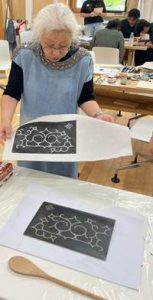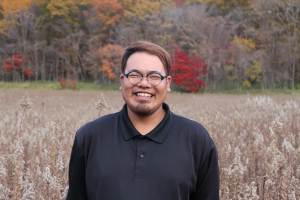Cross-Cultural Artistic Fusion: The Aboriginal Printing Workshop in Nibutani
GSI website blog text by Kanako Uzawa June – July 2024
In the heart of Nibutani, Biratori town, an inspiring event brought together Aboriginal and Ainu artists for a unique cross-cultural artistic experience. The Aboriginal printing workshop, held from June 25 to June 27, 2024, became a vibrant meeting point where creativity flourished and cultural boundaries dissolved.
The workshop concluded with a few Aboriginal and Ainu art screenings and documentary films at the Historical Museum of Saru River in Nibutani. This event featured 11 talented artists from diverse backgrounds, including wood carvers, embroiderers, filmmakers, performing artists, and weavers, representing various ages and genders.
Guided by instructor Julian Laffan, the participants were introduced to various materials such as lino and wood. Seeking additional inspiration, they also incorporated natural elements like leaves and stones gathered from a nearby waterfall in the Nibutani area. Throughout the three day-long workshop, artists exchanged ideas, experimented with different carving techniques, and explored the possibilities offered by various printing materials.
One of the highlights of the workshop was a collaborative piece where each artist contributed to the same carving board. This process allowed for a fascinating interplay of interpretations. For instance, a fish-like figure could be seen as a wave or a tree, depending on the artist’s perspective. Each artist added their unique message to the board, creating a significant artwork that beautifully encapsulates the stories of Aboriginal and Ainu people.
This workshop not only fostered artistic innovation but also deepened the cultural connections between Aboriginal and Ainu communities, leaving a lasting legacy of shared creativity and mutual respect.

1. Kanako Uzawa
出身地 Birth Place 北海道苫小牧 Tomakomai, Hokkaido
The workshop we had in Nibutani, Hokkaido, was a transformative experience for me, and I like to believe that we all feel the same way.
It was transformative because our Indigenous knowledge, tradition, experience, and voice became one large artwork.
An artwork we can all walk through, touch, smell, and feel.
As my Indigenous sister here, Mayatile, says, “Art is our life and our life is art.” Nobody was trying to create something aesthetically beautiful in this workshop, but rather something that tells our continuous life story over hundreds of years or even more. The narratives and stories are powerful and bond us together.
For myself, I used my hands and hand tattoos from both Aboriginal and Ainu designs. By doing so, I brought our traditional practices back to life. My hands became a platform where living designs danced together.
I want to discuss two key words today: “continuity” and “voice.”
“Continuity” because that is who we are.
“Continuity” because we are knowledge holders.
“Continuity” because we pass on our love and passion to the next generation.
During my youth, I searched for my voice. It took many years to find it, but then I started thinking, whose voice is it really? The question became stronger when I entered the academia and the museum world. Is it my voice, your voice, or our voice?
Our workshop created our voices, expressed and presented in many forms and shapes. Voices can be spoken verbally, but it can also be non-verbal.
Non-verbal voices can sometimes be more powerful than verbal voices.
I would like to ask you all where your true voices are.
Is it within yourself or within ourselves?
I think and learned from this workshop that our prints became something that embodied our non-verbal voices and knowledge, which makes everyone feel part of this world and leads us to a more innovative and creative future together.
Thank you.
私たちが北海道の二風谷で行ったワークショップは、私にとって先住民族アートについての認識や視野を広げる経験になりました。そして、他の参加者も同じように感じていると思います。 その大きな理由は、私たちの先住民族の知識、伝統、経験、そしてその声が一つの大きなアート作品になったからです。 そのアート作品は、私たちの目で観て、匂いを感じ、手で触れながら作品を感じるものになりました。
ここにいる私の先住民族の姉妹、マヤティリさんが言うように、「アートは私たちの生活であり、私たちの生活はアートです。」このワークショップでは、美的に美しいものを作ろうとしていたのではなく、何百年、さらにはそれ以上にわたる私たちの継続的な生活の物語を語るものを作ろうとしていました。 その物語の力は強く、私たちの絆をより強く結びつけてくれました。
私自身、アボリジニーとアイヌのアーティストにそれぞれのデザインを手に描いてもらい、コンテンポラリーダンスを踊りました。 そうすることで、私たちの伝統的な実践を蘇らせました。私の手は、生きているデザインが一緒に踊るプラットフォームとなりました。
ここで注目したい言葉は2つ。「連続性」と「声」の二つのキーワードです。
「連続性」は、私たちが誰であるかを表すものです。
「連続性」は、私たちが知識の保有者であることを意味します。
「連続性」は、私たちの愛と情熱を次の世代に伝えることを意味します。
若い頃、私は自分の声を探していました。それを見つけるのに何年もかかりました。しかし、その後、これは本当に誰の声なのかということを問い始めました。 学問の世界や博物館の世界に入ったとき、この質問はさらに強くなりました。これは私の声なのか、あなたの声なのか、それとも私たちの声なのか?
私たちのワークショップは、私たちの声をさまざまな形で表現し、アートと言う形で提示しました。 声は口頭で話されることもありますが、非言語の表現をすることもあります。 非言語の声や表現方法は、時には口頭の声より強いメッセージ性を持ちます。
皆さんにお尋ねしたいのは、あなたの本当の声はどこにあるのかということです。 それはあなた自身の中にあるものなのか、それとも私たちの中にあるものなのか?
私がこのワークショップを通し学んだことは、私たちの作品は、私たちの非言語的な声と知識を体現するものとなり、皆がこの世界の一部であると感じ、共により革新的で創造的な未来へと導いてくれるものになるということです。
2. 平村太幹 Daiki Hiramura
出身地 Birth Place 北海道平取 Biratori, Hokkaido
ワークショップを通してアボリジニの文化を少ししれた気がしました。今回はゴム版画や版画を体験して、様々なやり方があって刺激になりました。 アボリジニの文様とアイヌの文様と似てるところがあり、自然から取り入れたものや物語から取り入れた文様があってアイヌと共通しているなと感じました。
「その作った作品はどう言う意味?」
自分の作品のテーマはアイヌと自然と連続性を意識しました。 マカウシの滝で見て感じたものを作品に取り入れました。 今回のワークショップでは自然からインスピレーションをもらって作品にするっていことがはじめてで、完成してみたら今までにない感動だったり良い経験ができて良かったです。
Through the workshop, I felt that I got to know a little about Aboriginal culture. This time, experiencing rubber (lino) printmaking and other types of printmaking was stimulating due to the variety of techniques involved. I noticed similarities between Aboriginal patterns and Ainu patterns; both incorporate elements from nature and stories, which I found to be a commonality with the Ainu.
Regarding the artwork we created, I wondered about its meaning.
The theme of my work focused on the continuity between the Ainu and nature. I incorporated what I saw and felt at Makauchi waterfalls into my piece. This workshop was my first time receiving inspiration from nature and transforming it into an artwork. Upon completion, I felt unprecedented emotion and satisfaction, and it turned out to be a wonderful experience.


3. 高野啓子 Keiko Takano
出身地 Her Birthplace is Tokyo. She has lived in Hokkaido for 52 years, moving there in 1972.
他の文化を知ることはとても大切。自分にとっても刺激があった。そして、その人達と出会ったことで心が豊かになった。特に若い人達やアイヌ文化にとってもとても役立つと思う。模様、版画、かご編みもそうだけれど、自分の文化を高めることが出来ると思う。とても貴重な時間でした。
「その作った作品はどう言う意味?」
刺繍紋様でオリジナルで作ってみた。自然をもとにしたもの。版画でもこのような紋様が出来るのかと改めてわかりました。
Learning about other cultures is very important. It was stimulating for me as well, and meeting those people enriched my heart. I believe it is especially beneficial for young people and Ainu culture. Whether it’s patterns, printmaking, or basket weaving, I think it can enhance one’s own culture. It was a very valuable time.
“What does the artwork you created mean?”
I tried creating an original embroidery pattern based on nature. I realized once again that such patterns can also be made with printmaking.

4. 岡本朋也 Tomoya Okamoto
出身地 浦河町 Her Birthplace is Urakawa Town
オーストラリア先住民のリノカット版画技法というものを使って、若手がデザインしたアイヌ文様とコラボレーションをしました。ゴム版画でしたので、彫るのはサクサク彫れて、彫りやすかったです。それぞれの若手も個性を出し素晴らしい作品がたくさんできていて良かったと思います。
私がデザインして、彫ったものが、扇子に使われていて、面白いアイデアと色々な可能性も感じました。3日間という短い期間で、言語の壁を超えて、同じ先住民族としての誇りを感じ距離が縮まった気がします。この経験を活かして今後の工芸活動に役立てていきたいと思います。そしていつか私たちがオーストラリアに行き今回来ていただいた方たちに再会したいと思います。
Using the lino-cut printmaking technique of Australian Indigenous people, we collaborated with young artists through Ainu patterns. Since it was rubber printmaking, the carving was smooth and easy. I think it was great that each young artist expressed their individuality, resulting in many wonderful works.
The design I created and carved was printed on a fan, which gave me a sense of the interesting ideas and various possibilities. Despite the short period of three days, we managed to overcome language barriers and felt a sense of pride as fellow Indigenous people, bringing us closer together. I hope to use this experience in my future craft activities and look forward to the day when we can visit Australia and reunite with those who came here.

5. 西山 涼 Ryo Nishiyama
出身地 振内町 His Birthplace is Furenai Town.
今回のワークショップはとても楽しい体験になりました。
オーストラリアの皆さんと1日ずつしっかりと交流できたことがとても良い体験になりいいおもいでとなりました。
体験については最初は何から手をつけていけばいいかもわからずでしたが1日目が終わる頃には自分のやりたい文様が思いつきしっかりとした作品作りをできたと思います。
また、オーストラリアの皆さんのデザイン力には驚きました。
特に川や風景をそのデザインに落とし込みそこから自分たちのルーツなどに繋げていくのが驚きました。
自分はアイヌ文様に固定概念があり、そこからルーツや思いをデザインに乗せるのがとても苦手なので新たな発見ができて良かったです。
今後、僕たちも今回のワークショップを通してたくさんのヒントをもらえたのでどんどん実践して広める活動に活かしていきたいと思いました。
ありがとうございます。
ソンノ イヤイライケレ!!
This workshop was a very enjoyable experience. It was a great experience and a wonderful memory to be able to interact closely with everyone from Australia each day.
At first, I didn’t know where to start with the activities, but by the end of the first day, I had come up with the pattern I wanted to create and could make a solid piece of work.
I was also amazed by the Australians’ design skills. I was especially impressed by how they incorporated elements like rivers and landscapes into their designs, connecting them to their roots.
I realized that I had a fixed concept of Ainu patterns, and I found it difficult to incorporate my roots and feelings into my designs. This workshop was a great opportunity for new discoveries.
In the future, we hope to take the many hints we received from this workshop and apply them to our activities, spreading and sharing what we learned.
Thank you very much.
Sonno Iyayraykere! (Thank you very much in Ainu)



